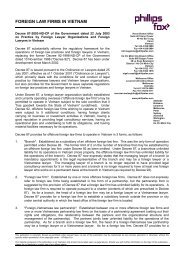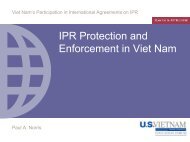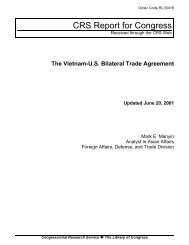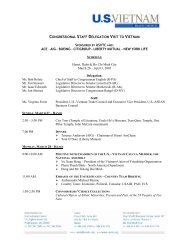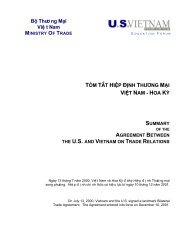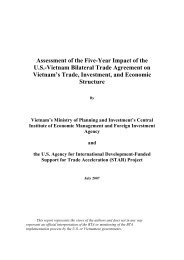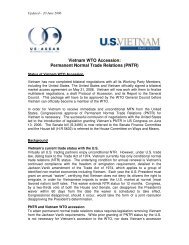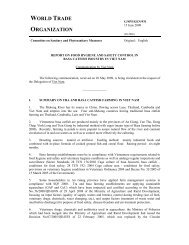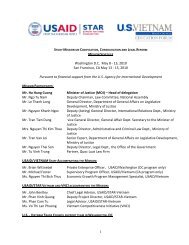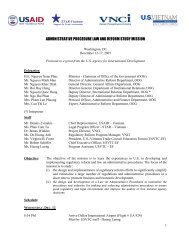Climate risks and adaptation in Asian coastal megacities: A synthesis
Climate risks and adaptation in Asian coastal megacities: A synthesis
Climate risks and adaptation in Asian coastal megacities: A synthesis
- No tags were found...
You also want an ePaper? Increase the reach of your titles
YUMPU automatically turns print PDFs into web optimized ePapers that Google loves.
hydrometeorological data, yield<strong>in</strong>g <strong>in</strong>formation onfloods <strong>and</strong> droughts <strong>and</strong> on the jo<strong>in</strong>t occurrence ofvariables, like the pattern of precipitation over alarge watershed. Dynamic models that are nested<strong>in</strong> AOGCMs are necessarily bound to the parentmodel’s <strong>in</strong>tr<strong>in</strong>sic biases. There is, for example, awide variation <strong>in</strong> the results of the AOGCMs <strong>in</strong>forecast<strong>in</strong>g extreme precipitation, <strong>and</strong> use of onemodel alone can yield unreliable results. Statisticalmodels yield s<strong>in</strong>gle parameters <strong>and</strong> shed little lighton the jo<strong>in</strong>t probability of occurrence. Nevertheless,because the results are based on a correlationwith the results of many models, the downscaledparameters have less <strong>in</strong>tr<strong>in</strong>sic bias than those generatedby a s<strong>in</strong>gle model. These constra<strong>in</strong>ts need to beconsidered <strong>in</strong> undertak<strong>in</strong>g similar city-level studies.Need to forge stronger l<strong>in</strong>ks betweenmethodologies developed by disaster riskreduction community <strong>and</strong> climate change<strong>adaptation</strong>There is a strong global consensus on the <strong>in</strong>creas<strong>in</strong>glyurgent need to address the underly<strong>in</strong>g causes of climatechange <strong>and</strong> its impacts through mitigation ofgreenhouse gas emissions <strong>and</strong> development of effective<strong>adaptation</strong> strategies. This has been underscoredat the recent United Nations Framework Conventionon <strong>Climate</strong> Change (UNFCCC) Conferences of Parties(COP) <strong>in</strong> Copenhagen (COP-15), which aga<strong>in</strong>highlighted the need to foster better l<strong>in</strong>kages betweenclimate change <strong>adaptation</strong> (CCA) <strong>and</strong> disaster riskreduction (DRR). The Hyogo Framework of Action,signed by 168 countries <strong>in</strong> 2005, is the guid<strong>in</strong>g documentfor the DRR <strong>in</strong>itiatives to ma<strong>in</strong>stream DRR <strong>in</strong>tothe national, sectoral, <strong>and</strong> local-level developmentplann<strong>in</strong>g process. The DRR community has wellestablishedprocedures <strong>and</strong> terms of reference for riskassessment, <strong>in</strong>clud<strong>in</strong>g probabilistic risk assessment,that allow assessment of <strong>risks</strong> based on an analysisof hazards, exposure, vulnerability, <strong>and</strong> capacity(ECLAC 2003). The use of simulation models to developevent-loss relationships are likewise commonlyapplied <strong>in</strong> the DRR work (e.g., hydrometeorological,earthquake, storm surge, tsunami, <strong>and</strong> l<strong>and</strong>slidemodels). In addition, the DRR community has thelocal networks <strong>and</strong> knowledge management systemsthat will provide significant benefit for climatechange <strong>adaptation</strong> studies. These synergies need tobe recognized <strong>and</strong> strengthened.Lessons with respect to damage costanalysis <strong>and</strong> prioritiz<strong>in</strong>g <strong>adaptation</strong> optionsThe three studies were based on available data. Thismeant that various assumptions had to be maderegard<strong>in</strong>g the number of households affected, the“damage rate” or extent of damage to various assetsas a result of floods of different <strong>in</strong>tensity, <strong>and</strong> thecosts associated with these damages. The underly<strong>in</strong>gdata <strong>and</strong> valuation would be much improved ifthere was scope for survey-based data collection. Arather important gap <strong>in</strong> the studies is the analysisof health impacts. Floods do have serious healthconsequences <strong>and</strong> while the studies have attemptedto estimate these, the full importance of these impactshas not been captured. To carefully exam<strong>in</strong>ethe health impacts of floods would require first anestimation of disease prevalence <strong>in</strong> the future (tak<strong>in</strong>g<strong>in</strong>to account climate <strong>and</strong> economic conditions)<strong>and</strong> second, application of robust dose-responserelationships to establish the extent of flood-relatedillnesses. This is an impact issue that requires morecareful consideration. In terms of <strong>adaptation</strong> toclimate change, the Bangkok <strong>and</strong> Manila studiesare unable to <strong>in</strong>corporate “soft options” such aschanges <strong>in</strong> legal <strong>and</strong> <strong>in</strong>stitutional issues <strong>in</strong>to theircost-benefit analyses. Thus, it is possible that thereare less costly policy changes that might br<strong>in</strong>gabout the same type of results as the eng<strong>in</strong>eer<strong>in</strong>gsolutions identified. However, identify<strong>in</strong>g the fullimplications of different policy reforms <strong>and</strong> then<strong>in</strong>corporat<strong>in</strong>g these <strong>in</strong>to a cost-benefit frameworkis difficult. Future studies would do well to lookat behavioral change options, zon<strong>in</strong>g possibilities,legal <strong>and</strong> <strong>in</strong>stitutional reforms, <strong>and</strong> conservationpossibilities carefully <strong>and</strong> rank them relative toeng<strong>in</strong>eer<strong>in</strong>g solutions.Need for detailed <strong>in</strong>stitutional analysis <strong>in</strong>future studiesIn undertak<strong>in</strong>g similar studies <strong>in</strong> the future, a moredetailed analysis of <strong>in</strong>stitutional <strong>and</strong> organizationalcapacity for urban <strong>adaptation</strong> is suggested. Whileall three city studies considered <strong>in</strong> this report doConclusions <strong>and</strong> Policy Implications | 79



